Chapter 5 Answer Key
5.7 Exercises
-
- Translating conjunctions. Use the following translation key to translate the following sentences into our logical language.
- (C&I)
- ((R&Y) →H)
- (H→~T&C)
- (I&~T)
- ~(C&I)
- Conjunction truth tables. Fill out the truth table for the following conjunctions.
P Q (P & Q) T T T T T T F T F F F T F F T F F F F F P Q (Q & P) T T T T T T F F F T F T T F F F F F F F - Conjunction truth tables. Fill out the truth table for the following conjunctions.
A B (A & B) T T T T T T F T F F F T F F T F F F F F A B (B & A) T T T T T T F F F T F T T F F F F F F F - Complex truth tables. Make truth tables for the following complex sentences.
- (P&~Q)
P Q (P & ~ Q) T T T F F T T F T T T F F T F F F T F F F F T F - ((P&Q)&(Q&P))
P Q ((P & Q) & (Q & P)) T T T T T T T T T T F T F F F F F T F T F F T F T F F F F F F F F F F F - ((P→Q) & ~Q)
P Q ((P → Q) & ~ Q) T T T T T F F T T F T F F F T F F T F T T F F T F F F T F T T F - (~P&~Q)
P Q (~ P & ~ Q) T T F T F F T T F F T F T F F T T F F F T F F T F T T F
- (P&~Q)
- Complex truth tables. Make truth tables for the following complex sentences. Identify which are tautologies and which are contradictions or contingent sentences.
- (((P→Q)& ~Q) → ~P)
P Q (((P → Q) & ~ Q) → ~ P) T T T T T F F T T F T T F T F F F T F T F T F T F T T F F T T T F F F F T F T T F T T F Look at the column for the main connective, conditional: on every row, the sentence is true, so it is a tautology.
- ~(P&Q)
P Q ~ (P & Q) T T F T T T T F T T F F F T T F F T F F T F F F Look at the column for the main connective, negation: there is at least one row where the sentence is true, and at least one row where the sentence is false, so it is contingent.
- ~(~P →~Q)
P Q ~ (~ P → ~ Q) T T F F T T F T T F F F T T T F F T T T F F F T F F F T F T T F Look at the column for the main connective, negation: there is at least one row where the sentence is true, and at least one row where the sentence is false, so it is contingent.
- (P&~P)
P (P & ~ P) T T F F T F F F T F Look at the column for the main connective, negation: there is at least one row where the sentence is true, and at least one row where the sentence is false, so it is contingent
- (((P→Q)& ~Q) → ~P)
- Truth table logical equivalence. Determine whether each pair of sentences is logically equivalent. Justify your answer with a complete truth table.
- P, ~P
P ~ P T F T F T F Look at the main logical connectives, P itself, and negation. We can see that they do not have the same truth value on every row, so they are not logically equivalent.
- P, (P → P)
P (P → P) T T T T F F T F Look at the main logical connectives, P itself, and conditional. We can see that they do not have the same truth value on every row, so they are not logically equivalent.
- ~(P→Q), (~P→~Q)
P Q ~ (P → Q) (~ P → ~ Q) T T T T F T F T T F T T F F T T F F T T T F F T T F F T T F F F T F F F T T F T F T T F Look at the main logical connectives, negation and conditional. We can see that they do not have the same truth value on every row, so they are not logically equivalent.
- (P→Q), (~Q→~P)
P Q (P → ~ Q) (~ Q → ~ P) T T T F F T F T T F T T F T T T F T F F F T F T F T F T F T T T F F F F T T F T F T T F Look at the main logical connectives, both conditional. We can see that they do not have the same truth value on every row, so they are not logically equivalent.
- P, ~P
- Complex truth tables. Make one large truth table to show when the following sentences are true and when they are false. State which of these sentences are equivalent.
- ~(P&Q) (~P&~Q) ~(P→Q) (P&~Q) (~P&Q) ~(~P→~Q)
P Q ~ (P & Q) (~ P & ~ Q) ~ (P → Q) (P & ~ Q) (~ P & Q) ~ (~ P → ~ Q) T T F T T T F T F F T F T T T T F F T F T F T F F T T F T T F T T F F F T F T F T T F F T T T F F T F F F F T T T F F T T F F T T F F F T F F T T F T F T T F T T T T F F F T F F T F F F T F T T F F F T F F T T F T F F F F T F T T F Looking at the columns for the main connective of each sentence. We can see that on every row, ~(~P→~Q) has the same truth value as (~P&Q), so they are logically equivalent; we can see that on every row, ~(P→Q) has the same truth value as (P&~Q), so they are logically equivalent
- ~(P&Q) (~P&~Q) ~(P→Q) (P&~Q) (~P&Q) ~(~P→~Q)
- Proofs. Complete a direct derivation (also called a “direct proof”) for each of the following arguments, showing that it is valid. You will need the rules modus ponens, modus tollens, adjunction, and simplification.
-
- Justification. Here are the answers to the proofs. Please select the appropriate justifications for each derived proposition.
- Premises: (P→Q)&~Q. Conclusion: ~P

- Premises: ((P→Q)&(R→S)), (~Q&~S). Conclusion: (~P&~R)
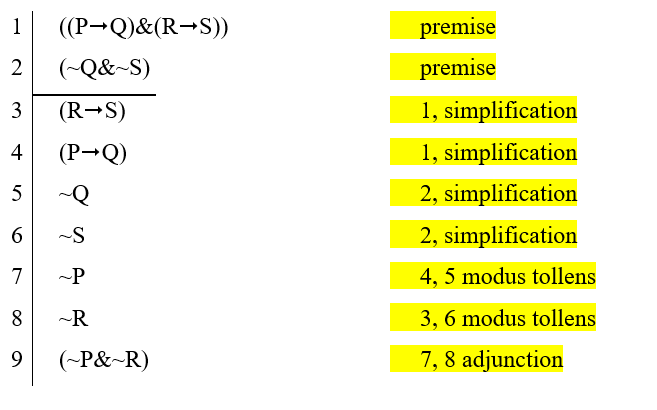
- Premises: ((R&S)→T), (Q&~T). Conclusion: ~(R&S)

- Premises: Premises: (P→(R→S)), (R&P). Conclusion: S
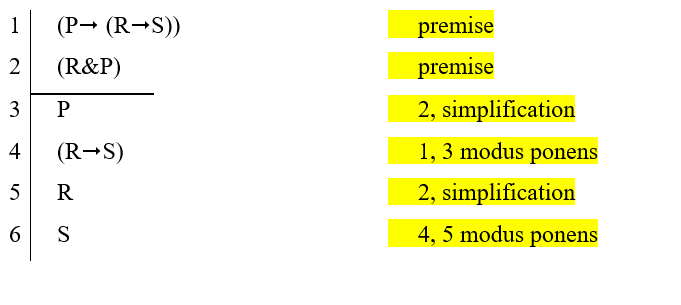
- Premises: Premises: (P→(R→S)), (~S&P). Conclusion: ~R

- Premises: (P→Q)&~Q. Conclusion: ~P
- Sentences. Here are the answers to the proofs. Please select the appropriate sentence for each derived proposition.
- Premises: (P→Q)&~Q. Conclusion: ~P
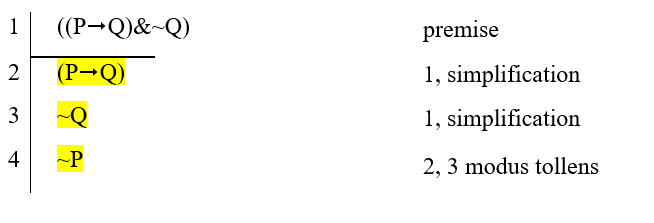
- Premises: ((P→Q)&(R→S)), (~Q&~S). Conclusion: (~P&~R)
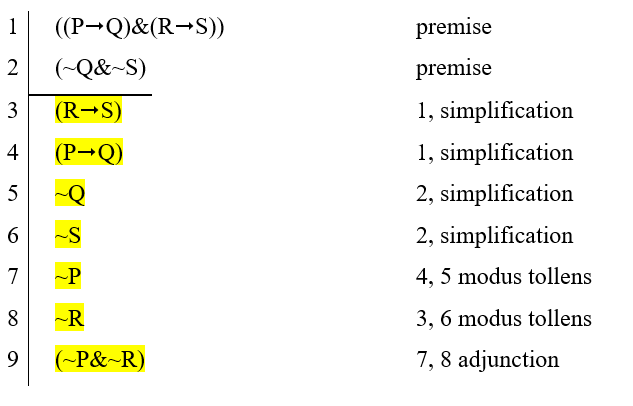
- Premises: ((R&S)→T), (Q&~T). Conclusion: ~(R&S)

- Premises: Premises: (P→(R→S)), (R&P). Conclusion: S
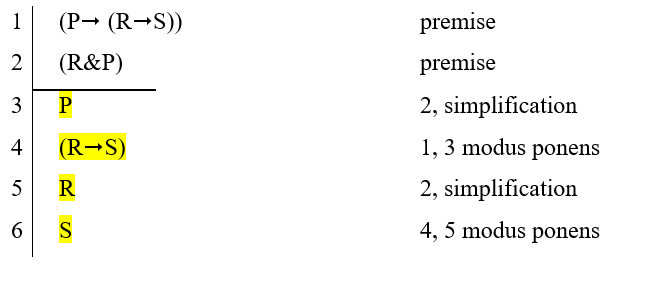
- Premises: Premises: (P→(R→S)), (~S&P). Conclusion: ~R
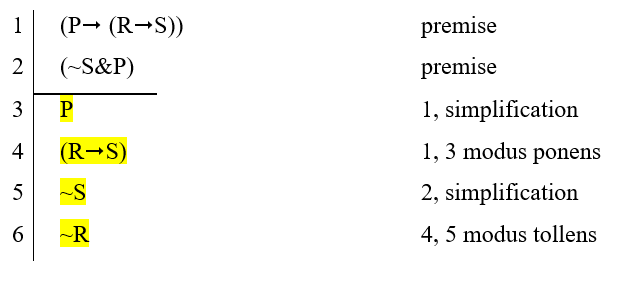
- Premises: (P→Q)&~Q. Conclusion: ~P
- Justification. Here are the answers to the proofs. Please select the appropriate justifications for each derived proposition.
-
- Translating conjunctions. Use the following translation key to translate the following sentences into our logical language.

